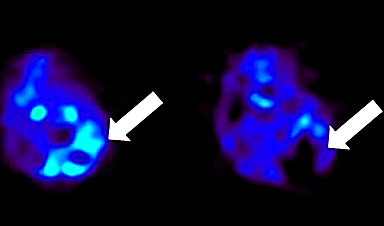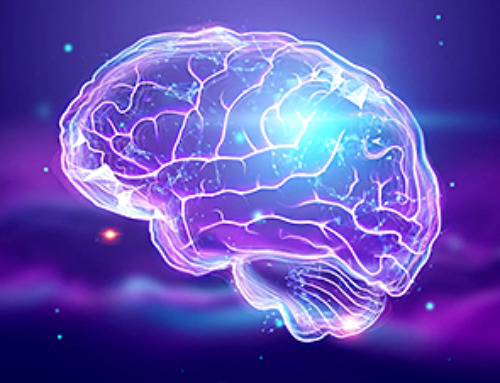A multidisciplinary research team at Vanderbilt University and Vanderbilt University Medical Center has discovered a new way to kill a tumor by disrupting its acidic “microenvironment” without harming normal tissue.
The target of this unorthodox approach is hydroxyapatite (HAP), a naturally occurring mineral that is a major component of bone and teeth but is also produced by some tumors.
In the extracellular microenvironment that surrounds and nourishes tumors, HAP crystals can enhance tumor cell proliferation, progression, and migration (metastasis). However, HAP is absent in normal soft tissue, making it an attractive target for cancer imaging and treatment.
Using various molecular analytical methods, the researchers identified and synthesized a nanoparticle that, when delivered via an injectable solution called NSPS, chelated or bound to calcium on tumor-associated HAP crystals, causing them to dissolve.
Dissolution triggered localized alkalosis, a sudden reversal in the acidity of the tumor microenvironment that was strong enough to kill breast cancer cells grown in culture and to slow tumor growth in animal models of human breast, colon, lung, and prostate cancers.
At the same time, NSPS demonstrated limited interaction with normal soft tissue and bone, the researchers report in the journal Cancer Medicine. These findings suggest that NSPS may be, in their words, “a one-of-a-kind and first in a class of novel cancer therapeutics.”
The paper’s corresponding author, Mohammed Tantawy, Ph.D., MBA, is a research associate professor of Radiology & Radiological Sciences and a member of the Vanderbilt University Institute of Imaging Science at VUMC.
The microenvironment of tumors generally is more acidic than surrounding normal tissue. Acidity, by altering the structure or uptake of cancer drugs, may contribute to the resistance to chemotherapy exhibited by tumors such as triple-negative breast cancer, which has a high rate of recurrence and poor overall survival.
“There is an urgent clinical need for new treatment paradigms that could improve the outcome for cancer patients with poor prognosis,” the researchers noted. While further studies in humans are necessary, “NSPS has significant potential to be a paradigm-changing approach to the treatment of cancer patients with poor prognosis.”
Tantawy added, “Within the Institute of Imaging Science, we are fortunate to be able to take projects like this from initial conception through the development of novel ligands for detection and treatment of cancer into in vivo demonstrations based on multimodal imaging and even into human subjects.”
More information: Mohammed N. Tantawy et al, Tumor therapy by targeting extracellular hydroxyapatite using novel drugs: A paradigm shift, Cancer Medicine (2024). DOI: 10.1002/cam4.6812
Journal information: Cancer Medicine
News
Nanocrystals Carrying Radioisotopes Offer New Hope for Cancer Treatment
The Science Scientists have developed tiny nanocrystal particles made up of isotopes of the elements lanthanum, vanadium, and oxygen for use in treating cancer. These crystals are smaller than many microbes and can carry isotopes of [...]
New Once-a-Week Shot Promises Life-Changing Relief for Parkinson’s Patients
A once-a-week shot from Australian scientists could spare people with Parkinson’s the grind of taking pills several times a day. The tiny, biodegradable gel sits under the skin and releases steady doses of two [...]
Weekly injectable drug offers hope for Parkinson’s patients
A new weekly injectable drug could transform the lives of more than eight million people living with Parkinson's disease, potentially replacing the need for multiple daily tablets. Scientists from the University of South Australia [...]
Most Plastic in the Ocean Is Invisible—And Deadly
Nanoplastics—particles smaller than a human hair—can pass through cell walls and enter the food web. New research suggest 27 million metric tons of nanoplastics are spread across just the top layer of the North [...]
Repurposed drugs could calm the immune system’s response to nanomedicine
An international study led by researchers at the University of Colorado Anschutz Medical Campus has identified a promising strategy to enhance the safety of nanomedicines, advanced therapies often used in cancer and vaccine treatments, [...]
Nano-Enhanced Hydrogel Strategies for Cartilage Repair
A recent article in Engineering describes the development of a protein-based nanocomposite hydrogel designed to deliver two therapeutic agents—dexamethasone (Dex) and kartogenin (KGN)—to support cartilage repair. The hydrogel is engineered to modulate immune responses and promote [...]
New Cancer Drug Blocks Tumors Without Debilitating Side Effects
A new drug targets RAS-PI3Kα pathways without harmful side effects. It was developed using high-performance computing and AI. A new cancer drug candidate, developed through a collaboration between Lawrence Livermore National Laboratory (LLNL), BridgeBio Oncology [...]
Scientists Are Pretty Close to Replicating the First Thing That Ever Lived
For 400 million years, a leading hypothesis claims, Earth was an “RNA World,” meaning that life must’ve first replicated from RNA before the arrival of proteins and DNA. Unfortunately, scientists have failed to find [...]
Why ‘Peniaphobia’ Is Exploding Among Young People (And Why We Should Be Concerned)
An insidious illness is taking hold among a growing proportion of young people. Little known to the general public, peniaphobia—the fear of becoming poor—is gaining ground among teens and young adults. Discover the causes [...]
Team finds flawed data in recent study relevant to coronavirus antiviral development
The COVID pandemic illustrated how urgently we need antiviral medications capable of treating coronavirus infections. To aid this effort, researchers quickly homed in on part of SARS-CoV-2's molecular structure known as the NiRAN domain—an [...]
Drug-Coated Neural Implants Reduce Immune Rejection
Summary: A new study shows that coating neural prosthetic implants with the anti-inflammatory drug dexamethasone helps reduce the body’s immune response and scar tissue formation. This strategy enhances the long-term performance and stability of electrodes [...]
Scientists discover cancer-fighting bacteria that ‘soak up’ forever chemicals in the body
A family of healthy bacteria may help 'soak up' toxic forever chemicals in the body, warding off their cancerous effects. Forever chemicals, also known as PFAS (per- and polyfluoroalkyl substances), are toxic chemicals that [...]
Johns Hopkins Researchers Uncover a New Way To Kill Cancer Cells
A new study reveals that blocking ribosomal RNA production rewires cancer cell behavior and could help treat genetically unstable tumors. Researchers at the Johns Hopkins Kimmel Cancer Center and the Department of Radiation Oncology and Molecular [...]
AI matches doctors in mapping lung tumors for radiation therapy
In radiation therapy, precision can save lives. Oncologists must carefully map the size and location of a tumor before delivering high-dose radiation to destroy cancer cells while sparing healthy tissue. But this process, called [...]
Scientists Finally “See” Key Protein That Controls Inflammation
Researchers used advanced microscopy to uncover important protein structures. For the first time, two important protein structures in the human body are being visualized, thanks in part to cutting-edge technology at the University of [...]
AI tool detects 9 types of dementia from a single brain scan
Mayo Clinic researchers have developed a new artificial intelligence (AI) tool that helps clinicians identify brain activity patterns linked to nine types of dementia, including Alzheimer's disease, using a single, widely available scan—a transformative [...]





















